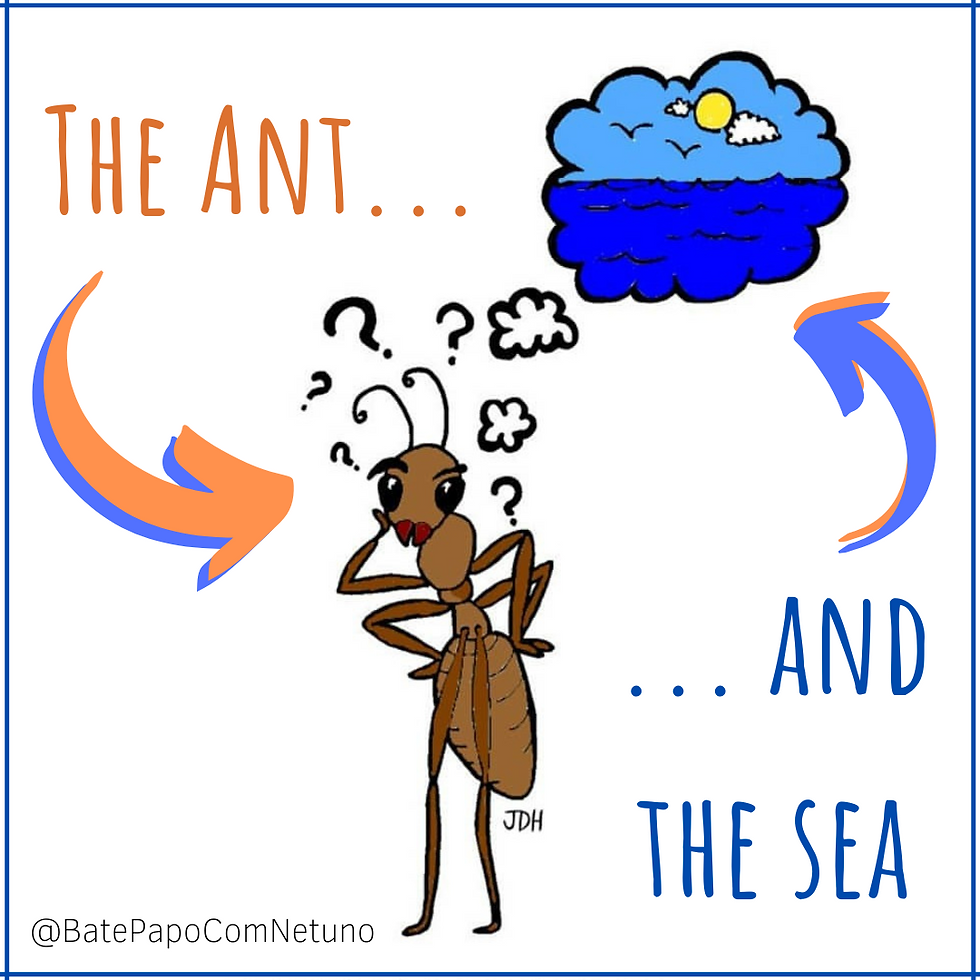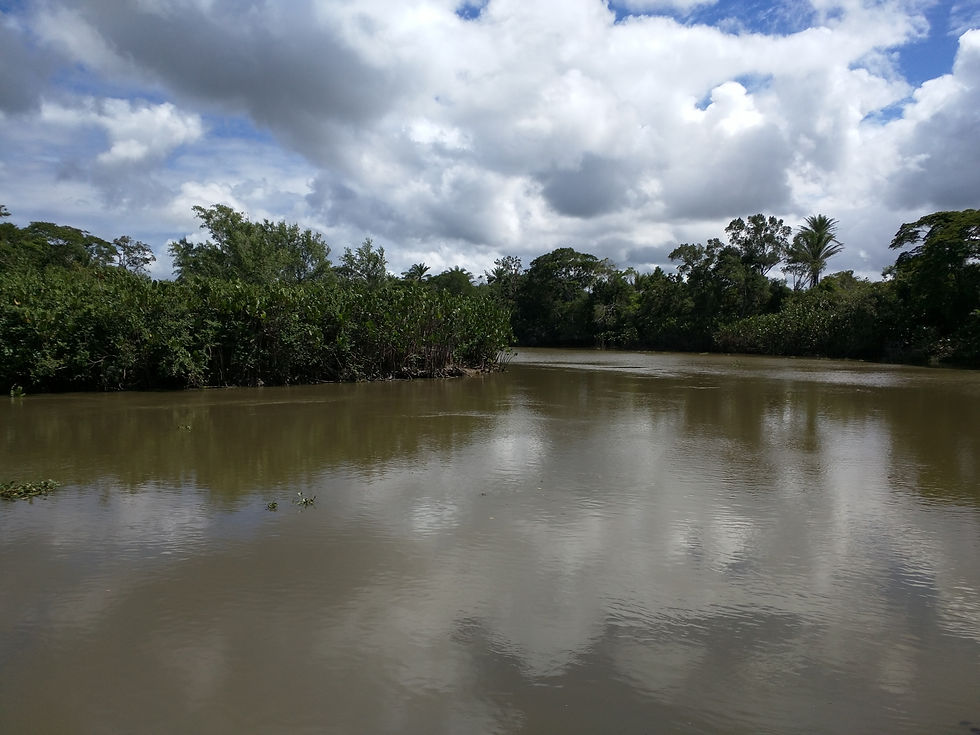The ant and the sea
- Bate Papo Com Netuno
- 18 de ago. de 2022
- 5 min de leitura
By Juliana Leonel
English edit by Lidia Paes Leme and Carla Elliff

Illustration by Joana Ho
No, we are not talking about a sea ant, nor are we talking about anthills at the bottom of the oceans. But yes, the ant and the sea are related. Come and find out how.
The ocean is intimately connected with the actions occurring on land, and in one way or another, almost everything reaches the ocean. Products/substances we use at home, in agriculture, and in industry, will one day reach the ocean, may it be through runoff, dumping, litter, or other waste removal processes.
Brazil plays an important role in supplying pulp and paper mills in several countries around the world (mainly China and countries in Europe). For this reason, our territory has extensive eucalyptus plantations which, due to its rapid growth and low planting costs, is an excellent source of raw material for these industries. However, eucalyptus plantations are a "full and tasty dish" for leaf-cutting ants that can cause total defoliation of the plants and lead them to death. Currently, to control these insects, granulated ant baits are used, Sulfluramid being the most widely used.
Eucalyptus plantations in the extreme south of Bahia, Brazil
(Photos by Juliana Leonel, CC BY SA)
Several researchers have observed that sulfluramid, after being released into the environment, changes into other chemical compounds after a few weeks. One of them, perfluorooctanesulfonic acid (PFOS), is highly persistent in the environment and has toxic effects on the biota, including us humans. Although PFOS is classified as a Persistent Organic Pollutant (POP) by the Stockholm Convention (learn more here), of which Brazil is a signatory, every five years the country requests authorization to continue using sulfluramid.
Some studies, conducted in 2012 and 2014, showed high values of PFOS in Brazilian seawater (see references listed below), which were not consistent with the industrial use of PFOS in the country. With this the question arose: would Sulfluramid be a significant source of PFOS for the coastal region of Brazil?
To answer this question, researchers from the Marine Pollution and Geochemistry Laboratory (LAPOGEO Mar) at the Federal University of Santa Catarina (UFSC) work in collaboration with other national and international institutions analyzing environmental samples and laboratory experiments. Thus, for the first time, a study (see references listed below) gathered data on the use, production, commercialization, export and import of the active ingredient of sulfluramid (EtFOSA - N-ethyl perfluorooctane sulfonamide ), showing that the import of EtFOSA by Brazil increased from 30 tons in 2007 to 60 tons in 2014.
The same study also evaluated the occurrence of PFOS and other perfluoroalkyl substances (PFASs) in surface waters of the Todos os Santos Bay (Bahia), where a profile of PFASs was found to correspond to the use of sulfluramid.
But the question was not yet answered, because the studies suggesting the degradation of sulfluramid to PFOS only analyzed soil and/or water and none of them studied the degradation from formicide baits, which are possible sources of this substance. From this, an experiment was designed to study this degradation in soil, with and without the presence of carrots (a vegetable chosen because it is easy to grow in the laboratory, it grows fast, and it is used in human food) (see references listed below). The study concluded that in a period of less than two weeks sulfluramid was degraded to PFOS in a greater amount than previously estimated. In addition, PFOS was absorbed from the soil by the carrot, and was distributed among its peel, its interior, and its leaves. In other words, foods grown near regions where sulfluramid is used may be exposed to PFOS.

Sampling materials for the study
(Photo by Juliana Leonel, CC BY SA)
At the same time, data generated from the analysis of samples (river, marine and groundwater, soil, leaf and sediment) from the Caravelas and Alcobaça region (extreme southern portion of Bahia, Brazil) helped to understand how the transport of sulfluramid and its degradation products can occur from the region where the substance if applied to the coast. This region was chosen because of the presence of extensive eucalyptus plantations. For example, 30.6% of the total area of the municipality of Caravelas is occupied by eucalyptus. This study allowed us to confirm the hypothesis that the use of sulfluramid in the eucalyptus plantations in Bahia is a significant source of PFOS for the coastal region. It is important to keep in mind that it is precisely in this region where the largest concentration of coral reefs in the South Atlantic Ocean is found, the Abrolhos reefs. In addition, the presence of PFOS (and other PFAs) in artesian well water was of particular concern, due to the potential for human exposure by consuming the water.

Alcobaça River (extreme southern region of Bahia, Brazil)
(Photos by Juliana Leonel, CC BY SA)
Unfortunately, although there are studies in search of alternatives, sulfluramid is considered the most efficient method to control leaf-cutting ants in Brazil and there is no prospect of its use being banned.
Studies like this one exemplify why the indiscriminate release of pesticides (there were more than 100 released in 2019 alone in Brazil) is so worrying, because once they are introduced into the environment, these compounds do not only affect the place where they have been applied and can remain in the environment for a long time (see the case of the occurrence of DDT in the Antarctic environment). Furthermore, little is known about the degradation products of most pesticides used in Brazil.
Additional reading and references:
Benskin, J.P., Muir, D.C.G., Scott, B.F., Spencer, C., De Silva, A., Kylin, H., Martin,J.W., Morris, A., Lohmann, R., Tomy, G., Rosenberg, B., Taniyasu, S., Yamashita, N., 2012a. Perfluoroalkyl acids in the atlantic and canadian arctic oceans. Environ. Sci. Technol. 46, 5815–5823.
González-Gaya, B., Dachs, J., Roscales, J.L., Caballero, G., Jimenez, B., 2014. Perfluoroalkylated substances in the global tropical and subtropical surface oceans. Environ. Sci. Technol. 48, 76–84.
Gilljam, J.L., Leonel, J., Cousins, I.T., Benskin, J.P., 2016a. Is ongoing Sulfluramid use in South America a significant source of perfluorooctane sulfonate (PFOS)? Production inventories, environmental fate, and local occurrence. Environ. Sci. Technol. 50, 653–659.
Gilljam, J.L., Leonel, J., Cousins, I.T., Benskin, J.P., 2016b. Additions and correction to is ongoing Sulfluramid use in South America a significant source of perfluorooctanesulfonate (PFOS)? Production inventories, environmental fate, and local occurrence. Environ. Sci. Technol. 50, 7930–7933.
Zabaleta, I., Bizkarguenaga, E., Nunoo, D.B.O., Schultes, L., Leonel, J., Prieto, A., Zuloaga, O., Benskin, J.P., 2018. Biodegradation and uptake of the pesticide sulfluramid in a soil/carrot mesocosm. Environ. Sci. Technol. 52, 2603–2611.
Nascimento, R. A., Nonoo, D. B. O., Bizkarguenaga, E., Schults, L., Zabaletab, I., Benskin, J. P., Spanó, S., Leonel, J. (2018). Sulfluramid use in Brazilian agriculture: A source of per- and polyfluoroalkyl substances (PFASs) to the environment. Envirom. Pol. 242, 1436-1443





Comments